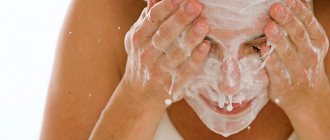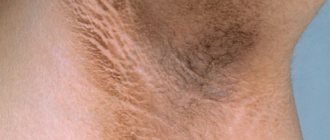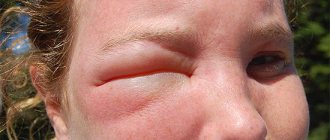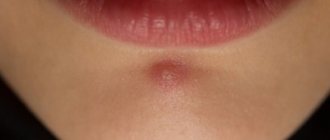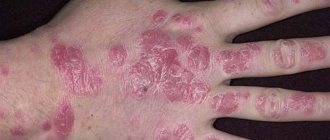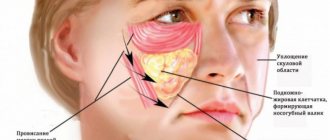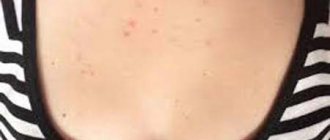What are the main causes of the disease?
People often experience a rash on the forehead with seborrheic dermatitis. You can also mention the popular name of the disease: seborrheic crown or seborrhea. There may be other reasons for red spots on the forehead of an adult. Less common are pathologies that have similar symptoms:
- The appearance of dermatophytosis of the face.
- The development of sebopsoriasis, that is, a combination of psoriasis with seborrhea.
- The occurrence of pityriasis versicolor.
- The appearance of urticaria.
Considering that seborrhea is the most common disease that causes red spots on the forehead in adults, it is worthwhile to dwell in more detail on the factors and treatment of this pathology.
ACNE ON THE FOREHEAD IN MEN: REASONS
What causes acne on the forehead in adult men? There are several main reasons.
Stress causes a sharp temporary increase in levels of androgens and the hormone cortisol, which stimulates the sebaceous glands to produce excess sebum. With chronic tension or moments of acute stress, the condition of the skin can worsen.
- Hormones
Hormones are one of the main causes of forehead acne in men. Hormonal imbalances can trigger acne. The powerful androgen testosterone is responsible for increasing sebum production starting in adolescence. Its excess, caused by hormones, can clog pores, leading to the development of acne on the forehead, nose, back, neck and scalp in adult men. Acne-causing bacteria are present on everyone's skin, but when there is overproduction of sebum oil, it creates an ideal environment for bacteria to grow and multiply.
Genetic predisposition is also considered one of the main reasons why men may develop acne on their forehead and face in adulthood. It is suggested that genetic factors are a more likely cause compared to diet and environmental factors.
- Excessive dry skin
Many acne-fighting products dry out the skin. This causes the sebaceous glands to work harder and produce even more sebum to soften the skin. This again can lead to clogged pores and breakouts.
- Chemicals in cosmetics
Facial products can irritate men's skin, causing inflammation that leads to acne. Hair products, shampoos, sprays, gels that get on the skin can also block pores.
- Dandruff and oily scalp
Dandruff and excess oil production can clog skin pores, causing acne. Dandruff is one of the most common causes of forehead acne in men. People with oily scalps are also more likely to develop acne on their neck, hair, and upper back.
- Excessive cleansing of facial skin
Too frequent washing with aggressive products, as well as excessive use of scrubs, can lead to irritation, flaking, increased sensitivity, disruption of the natural balance of the skin and, as a result, acne.
- Closed pores and oily skin type
Lack of cleansing can also cause acne. If skin cells are regenerating too much and a lot of sebum is being produced, pores can quickly become clogged and blocked. Without cleaning, they can become inflamed and turn into pimples.
Some foods, such as dairy and carbohydrates, can affect hormonal levels (especially insulin and IGF-1), which in turn can lead to acne.
Pimples on the forehead in men can appear due to constant friction (for example, from a hat), lack of hygiene, excessive sweating, taking medications (steroids, hormonal drugs, barbiturates), and in some people they develop after prolonged exposure to the sun.
The appearance of dandruff
The rashes can be located on the forehead, even reaching the hairline, which causes the appearance of scales, that is, dandruff. In order to establish a diagnosis, you need to contact a dermatologist who will evaluate the entire clinical picture of pathological formations. The causes and treatment are determined, as a rule, based on the results of an in-person examination. This is usually quite enough to prescribe treatment.
A special fungus provokes the appearance of such spots on this part of the face; the appearance of this pathology may also be associated with a deficiency of zinc or nicotinic acid in the human body. Exacerbation of seborrhea is observed more often in the cold season with a lack of ultraviolet radiation. In the summer it is quite rare to meet people with such unpleasant symptoms.
How can an adult get rid of red spots on the forehead of this kind?
Treatment of seborrhea
The skin in this area of the face, which is affected by seborrhea, requires special care and therapy. Local treatment is usually carried out. The disease can be chronic; therefore, it is necessary to follow the following recommendations for skin care:
- To eliminate the symptoms of the disease, a chatter containing zinc is used as therapy.
- During the hair washing process, a special medicated shampoo containing ketoconazole is used, as well as tar and zinc. During the procedure, shampoo foam can be used to wipe the skin where spots are present.
- In the morning, it is recommended to remove the crust on the stains using cotton swabs soaked in baby or medicated shampoo; you can wipe the areas with two percent Ketoconazole.
If you contact a specialist in a timely manner, such formations can be removed quite quickly. The causes and therapy in each case must be determined by a doctor who will prescribe individual treatment.
A photo of red spots on the forehead of an adult is presented.
Factors that provoke this phenomenon among the stronger sex are usually the following.
Authorized products:
- Wholemeal bread.
- Dairy products.
- Cereals.
- Legumes.
- Greens, vegetables, fruits.
- Lean boiled meat.
- Prohibited products:
- Eggs, sausage.
- Fish, caviar.
- Mushrooms, carrots, citrus fruits.
- Spices.
- Tea, coffee, alcohol.
Salt and sugar are allowed in limited quantities. You need to drink at least 1.5 liters of water per day - it will improve your metabolism and provide your skin with the necessary microelements.
Skin care for oral dermatitis includes the use of medications, ointments, creams, and traditional medicine.
For rashes, you need to treat the affected areas 3-5 times a day with decoctions of yarrow, calendula, celandine, and St. John's wort. To prepare the decoction, 2 tbsp. spoons of raw materials, pour 200 ml of boiling water, leave for 2-3 hours in a warm place. Strain and pour into a container with a tight lid. Use for wiping and lotions.
It is recommended to use medicinal compresses made from honey, onions and flaxseeds. Mix thoroughly 1 tbsp. spoon of each component, boil for 15 minutes in a water bath, strain, pour into a glass container. Soak gauze in the mixture, apply to the affected areas for 1 hour, remove the bandage, wipe your face with a decoction of herbs. Skin with dermatitis around the mouth can be treated with glycerin borax, soda solution, infusion of chamomile, plantain, St. John's wort.
Presence of heart and vascular diseases
Poor permeability of capillaries and their weak walls lead to tissue fragility, which is why stars form. The surrounding skin may take on a reddish tint. Similar spots also occur in the presence of a diseased stomach. The more obvious symptoms are belching along with diarrhea and flatulence, which confirms the problem of low acidity.
Red spots on the forehead in men can occur when coughing, choking, when using certain medications, as well as in extreme situations.
Spots in combination with other symptoms: what does this mean?
Is it dangerous if a red spot on an adult’s forehead peels off?
Sometimes they are one of the symptoms of extremely serious illnesses. Together with the following signs, these can warn:
- Against the background of blue lips or nails, this may indicate heart failure.
- About swelling of the throat.
- About strong heartbeat and rapid pulse.
The following signs may be life-threatening:
- Flaky red spots on the forehead sometimes occur due to a lack of vitamins “A”, “C”, “P”. At the same time, people’s skin loses moisture, becoming covered with dry scales. As a rule, this phenomenon is observed in the spring.
- There is a skin disease called demodicosis, which is caused by a mite. When infected, the described symptom may also be observed. The causes of redness may also be the presence of other parasites in the body.
- Ringworm, along with measles, chickenpox, rubella - all this can also provoke the appearance of this symptom on the face.
- Against the background of lupus erythematosus or psoriasis.
Treatment
Now let's talk about the features of therapy:
- Such spots on the face due to the sun, cold or other mechanical reasons, as a rule, do not require special treatment. It is enough to use nourishing or moisturizing creams. Vitamin deficiency is determined by a doctor who prescribes the use of the missing vitamin. But you can’t randomly take all micronutrients in a row. This can have a detrimental effect on your health.
- If you have an allergy, first of all, you need to identify and get rid of the irritant, and then take antihistamines prescribed by your doctor.
- In order to get rid of acne, complex therapy is used. We are talking about cleansing the face, using products that tighten pores and using hormonal medications.
- Therapy for helminthiasis usually begins with identifying the type of parasite through a blood test. Only then will the doctor be able to prescribe a drug for treatment.
- Ringworm can be contracted from a sick individual, as well as from a stray animal. This disease is quite difficult to treat. But a well-developed treatment tactic by a doctor will help get rid of such a serious skin disease forever.
- Infections like rubella, chickenpox and measles in children are quite easy, but at the same time predictable. The main thing is to start therapy on time. Adults suffer more severely from such diseases. They may experience certain complications. Chickenpox covers the entire body with a rash. If the pimples are not cauterized with brilliant green, then they will spread and cause fever.
- Lupus erythematosus and psoriasis are incurable diseases, but systemic therapy makes life easier for patients. On the skin, this disease manifests itself in the form of red raised spots on the face. Such inflammatory manifestations affect, among other things, internal organs.
- In the presence of severe sexually transmitted diseases, spots on the forehead may also appear. After getting rid of the underlying disease, the redness goes away by itself.
Therapy depending on the disease
An ailment such as eczema appears in the form of small red spots on any part of the face. They may become covered with watery blisters that burst and dry out. All of them can be very itchy. To get rid of eczema, antihistamines are taken internally to eliminate the causes of the pathology, and externally the skin is treated with ointments with tar or a solution of boric acid. In severe cases, the doctor prescribes hormonal ointments. For example, if you have contact eczema, Flucinar helps well.
Oral dermatitis is generally uncommon among men. Its main cause is usually poor functioning of the digestive system or hormonal dysfunction. After eliminating the underlying disease, treatment is carried out with calendula lotions or cryomassages should be performed.
Why do people's faces turn red in stressful situations? This is directly related to an increase in pressure in case of nervous excitement. In the brave, this reaction gives a rush of blood and strength, but in the weak, the face usually turns pale, that is, absolutely all processes completely freeze, and the blood runs cold in the veins due to fear. In the presence of diabetes, some blood vessels are affected, which leads to the formation of purple and red spots, complicated by ulcers. It's quite difficult to get rid of them.
The face turns red due to increased heart rate. Similar disorders occur in women during menopause. The reason for them lies in the rush of blood. Scarlet fever in adults is determined by the abundance of red small pimples, gradually turning into one field with white spots near the nose. Measles has its own distinctive features - these are red formations and a white coating on the mucous membrane of the cheeks on the back side. Rubella, in addition to the symptom in question, is characterized by swollen lymph nodes.
We looked at what red spots on the forehead of an adult mean. A photo with explanations is presented.
Possible reasons
A crust on the head can form as a result of the following disorders and factors.
- An allergic reaction to household chemicals or cosmetics, which you can read about here;
- Local manifestations of serious systemic problems (AIDS, HIV and other pathologies in the immune system);
- Pediculosis;
- Infection;
- Viruses (chickenpox, shingles, etc.);
- Endocrine disorders (thyroid diseases, etc.);
- Dermatitis, eczema;
- Other reasons.
The formation of sores can also be a harbinger of malignant neoplasms.
Let us take a closer look at the probable nature of the appearance of horny lumps in the scalp of an adult.
Psoriasis
Psoriasis of the scalp is a common skin disease that is associated with impaired functioning of T-cells of the immune system. They are responsible for the timely neutralization of a foreign agent and instantly react to the invasion by attacking and “eating” the microbe.
In the case of psoriasis, the sensitivity of these cells is disrupted, they begin to perceive their own skin cells as an enemy and attack. As a result of the attack, immune complexes and microdamages are formed, which are revealed outside.
In the initial stages of psoriasis, the surface of the patient's head is covered or has already become covered with a white crust that does not stop itching. Based on its external manifestations, psoriasis can easily be confused with:
- allergies;
- seborrheic dermatitis, which you can learn about in this article;
- hormonal disorders;
- crusts for pediculosis.
When the first white bumps and itching appear, you should immediately contact a dermatologist to find out which of these factors contributed to their occurrence. A correct diagnosis is a guarantee of correct treatment and getting rid of severe, unwanted complications, such as generalized infection and sepsis.
Psoriasis is treated with immunomodulatory drugs, antifungal ointments (as well as anti-inflammatory) and emollients to remove the stratum corneum. If a bacterial infection occurs, the patient will be prescribed antibiotics.
Seborrheic dermatitis
Seborrheic dermatitis or dandruff is a consequence of decreased immunity as a result of stress (less often, other factors) and activation of natural yeast fungus.
To make it clear, yeast is always present in a small proportion in humans, but natural immunity restrains reproduction and does not allow it to take over.
When the immune system is under attack, in the presence of other factors (in the case of dermatitis, this is increased secretion of sebum from the glands), the fungus is activated and manifests itself externally.
The main stages of the occurrence of seborrheic dermatitis.
- Increased fat content;
- The appearance of itching;
- Manifestation of microcracks and wounds;
- Clumping of dandruff under the influence of sebum into crusts.
If the disease is not treated, then over time the desire to scratch the crusts on the skin will be irresistible. When they harden, the process becomes very painful, wounds are formed into which bacteria can easily enter and cause an infection.
Dandruff is treated with special antifungal shampoos and ointments, as well as tablets for internal use (if the disease is advanced). When an infection occurs, antibiotics are also prescribed.
Eczema
With eczema, the head becomes covered with itchy scales and is very itchy. The root cause of this pathology is often a common allergy that has become chronic.
The growths are formed due to blockage of pores and inflammation resulting from stagnation of sebaceous secretions in these pores. Severe itching forces a person to scratch them, which causes wounds to form. Eczema is very painful.
For correction, antihistamines are mainly used (to relieve an allergic reaction of the immune response), ointments with hormones (to eliminate inflammation and itching) and special shampoos with an antifungal component (for seborrheic eczema).
Ringworm
Scabs on the head of an adult are rarely the result of ringworm. It occurs more often in children and is rightly considered a childhood disease. But exceptions are rare, so let’s take a closer look.
Ringworm is a contagious fungal disease that is transmitted from person to person through tactile contact. It appears on the hairy parts of the body, which immediately lose hair at the site of the fungus.
That's why it's called "cutting". It manifests itself as severe itching and pain. To correct the condition, painkillers and anti-inflammatory ointments, antifungal drugs and immunomodulatory medications are used.
Shingles
This is a viral disease that is caused by the chickenpox virus, which remains forever in a person after chickenpox.
The presence of the virus, on the one hand, is an obstacle to re-infection, but on the other hand, with a temporary decrease in immunity, it can manifest itself in the development of herpes zoster.
This disease is more common among older people and middle-aged people who had chickenpox in childhood.
Shingles is manifested by severe redness and the appearance of yellow, itchy growths in places of inflammation. They itch and itch so much that it is almost impossible to control them. The result is the constant formation of new wounds and the risk of developing bacterial complications.
The pathology is treated with antiviral medications, creams with analgesic and anti-inflammatory effects, as well as gentle washing liquids that soften inflammation and have an antibacterial effect. You can read more about shingles here.
Dry skin
Sebum, which is normally secreted by the exocrine glands and is necessary to lubricate the integument and constantly maintain the required level of moisture, can be released in excess, which leads to the formation of keratinization.
Some factors that cause the sebaceous glands to become overactive:
- Wash with hot water;
- Frequent washing;
- Prolonged exposure to cold;
- Frequent use of soapy, cleansing ingredients.
To treat such crusts on the head under the hair, it will be enough to adjust the temperature of the water for washing and reduce the frequency of using soapy liquids.
Pediculosis
If the nature of the scab on a child’s head is pediculosis, then everything is quite simple. Crusts arise due to the fact that the baby (sometimes an adult) constantly scratches them, and as a result of this, micro-wounds are formed, which become covered with growths.
You need to remove lice using killing sprays and lotions, and the growths will go away on their own.
Lichen planus lichen planopilaris
This is a disease of older people. The scalp and nearby skin are covered with red bumps, which become covered with a white crust when scratched.
These bumps are very itchy and painful, so the main focus of therapy is pain relief and elimination of itching. For this purpose, hormonal ointments with antifungal activity are prescribed. Sometimes antifungal medications are used internally.
Eosinophilic folliculitis
With eosinophilic folliculitis, scabs appear, which underneath have an inflamed ulcer with a purulent secretion. This disease is common to people affected by HIV or AIDS. This is due to decreased immunity and greater susceptibility to any bacteria.
Folliculitis is treated primarily with therapy against the systemic disease from which it resulted. Ointments with antibiotics and hormones are also used to quickly restore the skin.
Other reasons
Other causes of compaction may include the following.
- Impaired functioning of the thyroid gland and other endocrine glands;
- Deep stress;
- Allergy;
- Toxicity of household chemicals.
The face is very hot and red: causes, signs, solutions (6 photos)
It’s paradoxical, but people always lack what others have: pale-skinned people dream of rosy cheeks, while those with a rosy complexion are ashamed of it and even try to disguise it. If the face burns periodically, then this condition can be caused by external, psychological and some diseases.
External factors that provoke facial redness without fever
The main reason that causes unhealthy blush is temperature change. If a person has sensitive skin, then during a sharp cold or warming it reacts in this way.
Sunburn and frostbite can also cause redness: such factors provoke a lack of moisture and, as a result, thinning of the epidermis.
The skin also reacts with heat without temperature to bad habits, in particular alcohol and nicotine. Pressure surges and the development of edema are possible. It happens that the face burns after eating unusual spicy food. The response to such a dish can also be a rapid heartbeat and disturbances in the gastrointestinal tract. Active physical activity also causes facial flushing. It is important not to overdo it with them, because instead of good results in training, you can get a heart attack.
Diseases that cause the face to burn
A burning sensation and redness are observed in the following diseases:
- rosacea, acne, psoriasis, demodicosis and other skin diseases. Against their background, vasodilation occurs. The skin turns purple or bright pink and burns. Additional symptoms may include rash, papules, peeling scales of the epidermis;
- rosacea Develops due to impaired blood circulation and increased fragility of capillary walls;
- skin hypersensitivity;
- allergy. May be accompanied by itching. In most cases, it is a response to the use of decorative cosmetics;
- ARVI and colds. At the initial stage of the disease, there are no symptoms such as fever, runny nose, or cough. A feeling of heat on the skin of the face, general weakness and drowsiness are observed immediately after infection. Subsequently, chills, watery eyes, sneezing and other manifestations are added to them. In the acute phase, it is imperative to observe bed rest;
- osteochondrosis. With osteochondrosis of the cervical spine, a throbbing headache and redness of the face caused by a lack of oxygen are often felt;
- VSD. This disease is not always recognized as an independent disease and is often a complex of additional symptoms indicating another illness. With vasospasm, the face may turn completely red or become covered with scattered spots;
- hormonal changes. This condition is more common in women. It can be provoked by the beginning of a cycle, pregnancy, menopause;
- heart and vascular diseases. A red face is often a sign of hypertension and may be accompanied by headache, shortness of breath, and swelling;
- diabetes. This disease can have a variety of manifestations - blockage of small blood vessels, cracks in the lips, non-healing ulcers, small wounds. In this case, it is extremely important to follow the recommendations of your doctor to maintain normal sugar levels.
Psychological factors that can cause your face to burn
This symptom can be caused by stress, neurosis, prolonged nervous strain, and psycho-emotional fatigue. As a result of stress, blood flow may be impaired. Blood rushes to the head, causing an unhealthy flush and a feeling of heat.
Treatment: what to do for sweat on the face
If your face is sweating due to stress and neurosis, then you need to consult a psychotherapist
Some tablets act directly on the sweat glands, reducing their secretion and, as a result, sweating. These include oxybutynin and glycopyrrolate. You cannot buy them without a prescription; they are used for primary hyperhidrosis. There are also physiotherapy and surgical treatment methods, for example, taking a tablespoon of sour lemon juice orally.
The first is iontophoresis. You may also be offered to administer botulinum toxin preparations - Botox or Dysport. They are injected under the skin, into the scalp. Injections need to be repeated every 6-8 months.
If your answer to the question “why your face sweats a lot” is neuroses and depression, a psychotherapist will help you. A decrease in facial sweating will occur as the emotional background normalizes. In addition to medications, this specialist also includes auto-training and hypnosis. The most effective in such cases are mindfulness (mindfulness) and cognitive behavioral psychotherapy.
The most radical method is sympathectomy, transection of the sympathetic nerve and termination of its innervation of the sweat glands. Side effect - the doctor may accidentally disrupt the function of the facial muscles, so only resort to it if nothing else helps. We hope we have helped you understand the question of how to stop constantly sweating and what reasons may lead to this.
Causes of facial redness in men
Content
Red spots appear on the face of men for natural reasons:
from physical activity;
This should not be a cause for concern. But if the redness cannot be eliminated by eliminating the listed factors, then this may be caused by serious diseases that have not yet manifested themselves as more pronounced symptoms. This is a reason to be wary and consult a doctor. He will advise what to do. Whatever it takes, we need to identify the cause of the red rashes.
Causes of redness on the face:
- Eczema in men. Skin lesions occur due to contact with skin irritants - toxic chemicals, cuts and burns. Red spots on the face may indicate disorders in the digestive system or hormonal imbalance.
- An allergic reaction to external irritants or food causes red spots to appear on the face and body. Spices, citrus fruits, strawberries, chocolate, coffee are considered active allergens. Even a new shaving gel or foam can cause an allergy in a man.
- Alcohol lovers experience such skin manifestations due to high blood pressure and poor liver function.
- Acne. Pimples and acne usually appear during adolescence. High levels of androgens cause intense sebum production in enlarged pores. The pores are not cleaned and this causes inflammation. Similar phenomena can be observed in some men in old age, when the skin becomes red and bumpy.
- Cardiovascular diseases. Poor patency of blood vessels and their weak walls lead to fragility of small capillaries, the accumulation of which forms “stars”. The skin around them takes on a reddish tint. Similar spots on the skin appear with a sick stomach. More obvious symptoms - belching, diarrhea, flatulence - confirm the problem with low acidity.
- Red spots on the face appear when coughing, suffocating conditions, when using certain medications, in extreme situations.
- A red face is sometimes one of the symptoms of dangerous diseases.
Together with the following signs, it warns:
- Blue lips or nails indicate heart failure;
- Pressing pain in the chest;
- Shortness of breath and shallow breathing;
- Loss of consciousness, weakness, confused thoughts;
- Swelling of the eyes, throat;
- Strong heartbeat, rapid pulse.
Such signs can be life-threatening.
- Characteristic flaky red spots on the face occur with a lack of vitamin C, A, R. The skin loses moisture and becomes covered with dry scales. This phenomenon is usually observed in the spring. There is a skin disease called demodicosis caused by mites. The causes of redness may lie in the presence of parasites in the body.
- Diseases such as lichen, measles, chickenpox, rubella can also cause redness on the face.
- Lupus erythematosus.
- Psoriasis.
Causes of the disease
Depending on the causes, doctors distinguish such types of hyperhidrosis as primary and secondary. The first develops on its own, the second - as a concomitant pathology with other diseases. If you have primary facial hyperhidrosis, it will begin to manifest itself in adolescence: the skin of the face turns red, sweat appears above the upper lip. The peak occurs between the ages of 14 and 21. Heavy sweating and excessive sweating can occur in many different situations.
The face sweats a lot in hot weather and during intense physical exertion. It can also be caused by drinking alcohol. And finally, sweat comes from wearing tight synthetic hats (especially in hot weather) or eating spicy fried foods. In this case, getting rid of hyperhidrosis and stopping sweating is quite easy. But having changed your lifestyle, you need to follow it constantly in the future, otherwise the problem will return.
Sometimes hyperhidrosis is associated with your own body characteristics. Your face sweats during conditions such as pregnancy, menopause, and adolescence. Here, too, it will be enough to use our tips for prevention.
Pathological causes are also extremely diverse. These include endocrine disruptions, infectious diseases, diabetes, obesity and much more. The external signs of such diseases are quite typical. A very sweaty face is one of them, but, of course, not the main one and not the only one.
Treatment
- Red spots on the face from the sun, cold
or other mechanical causes do not require special treatment. It is enough to use nourishing or moisturizing creams. The doctor will determine vitamin deficiency and prescribe the intake of the missing vitamin. But you can’t take any vitamins randomly. This will have a detrimental effect on both your face and your health. - If you have an allergy,
first of all you need to identify and get rid of the allergen, and then take antihistamines prescribed by your doctor. - To get rid of acne
, complex treatment is used. This includes facial cleansing, using pore tightening products, and taking hormonal medications. - Treatment of helminthiasis
begins with identifying the type of parasite through a blood test. Only then can the doctor prescribe a drug for treatment. - Ringworm
can be “caught” from a sick person or a stray animal (cat, dog). This disease is difficult to treat and takes a long time. But a well-developed treatment tactic by a doctor will help you get rid of a serious skin disease forever. - Infections such as rubella, measles, and chickenpox
in children occur quite easily and predictably. The main thing is to start treatment on time. Adults suffer more severely from these diseases. Adults may experience complications after them. Chickenpox covers the entire body with a rash. If pimples are not burned with brilliant green, they spread and cause fever. - Lupus erythematosus and psoriasis
are incurable diseases, but systemic treatment makes the patient’s life easier. On the skin, this disease manifests itself as red raised spots on the face. Such inflammatory phenomena also affect internal organs. - With severe sexually transmitted diseases, spots may also appear on the face. After getting rid of the underlying disease, the redness will go away on its own.
Associated symptoms
Other symptoms that may appear when scabs form on the scalp include the following. Taking an anamnesis will help the doctor make the correct diagnosis and prescribe medications.
- Varying degrees of irritation (severely itchy head or not);
- Inflammation (presence of sores on the head);
- Pigmentation;
- White crusts;
- Dryness, exfoliation of horn cells;
- Color of the lesion.
Each disease has its own external manifestations, so the accompanying symptoms are very important.

